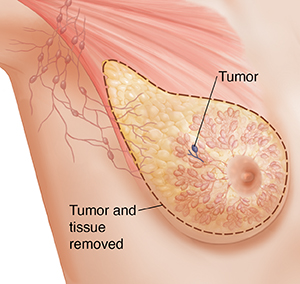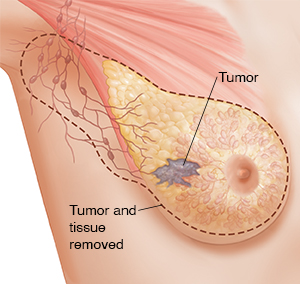Types of Surgery for Breast Cancer
Many kinds of surgery are used to treat breast cancer. The goal of each is to remove all of the cancer. You and your surgeon will decide which surgery is best for you. Breast reconstruction is often an option. Reconstruction is plastic surgery to rebuild the breast shape.
Lumpectomy
The goal of lumpectomy is to remove the cancer while keeping as much of the breast as possible. Lumpectomy is also called breast-conserving surgery. It is also called wide local excision. You may not need to stay in the hospital overnight for this surgery. Your surgery may be done at an outpatient surgery facility.
To do this surgery, the surgeon removes the breast tissue that contains the cancer cells. An edge of normal tissue (margin) around the cancer is also taken out. The tissue is sent to a lab for testing.
One or more lymph nodes under your arm might also be removed. They're tested to see if the cancer has spread to them.
More surgery may be needed if all of the cancer cells are not removed the first time. This may be the case if cancer cells are found in the outside edges of the tissue that was taken out.
Most people need radiation therapy after a lumpectomy. Sometimes other cancer treatments are needed, too. The goal is to keep the cancer from coming back in the same breast.

Simple or total mastectomy
During a simple or total mastectomy, the surgeon removes all of the breast tissue, plus your skin, nipple, and areola. Underarm lymph nodes might be removed. The lining over your chest muscles (fascia) is also removed. Your chest muscles are not removed. This surgery most often needs an overnight hospital stay.
Based on the results of surgery and follow-up tests, more treatment may be needed.

Modified radical mastectomy
During modified radical mastectomy, the surgeon removes all the breast tissue and your skin, nipple, areola, and fascia over the chest muscles. The chest muscles are left intact. Many of the lymph nodes in your armpit near your breast are removed. This surgery most often needs an overnight hospital stay.
Based on the results of follow-up tests, more treatment may be needed.

Lymph nodes and breast cancer
When cancer cells break away from a tumor, they tend to travel in the lymph fluid to nearby lymph nodes. During surgery, your first lymph node or nodes that drain the tumor may be removed and checked for cancer. This is called a sentinel node biopsy. In some cases, all of the nodes are removed.
If the lymph nodes contain cancer, the cancer may have spread to other parts of your body. More treatment is needed to kill any cells that may be left.
Risks of breast surgery
All surgery has risks. Risks of breast and lymph node surgery depend on the type of surgery that was done, and include:
-
Pain. This gets better as you heal and recover.
-
Numbness and muscle weakness in your chest and upper arm (from nerve damage)
-
Bleeding
-
Infection
-
Fluid collection in the treated area (seroma)
-
Long-term swelling of the arm, hand, or chest (lymphedema)
-
Shoulder stiffness
Your healthcare team can tell you what to expect based on the type of surgery you have.